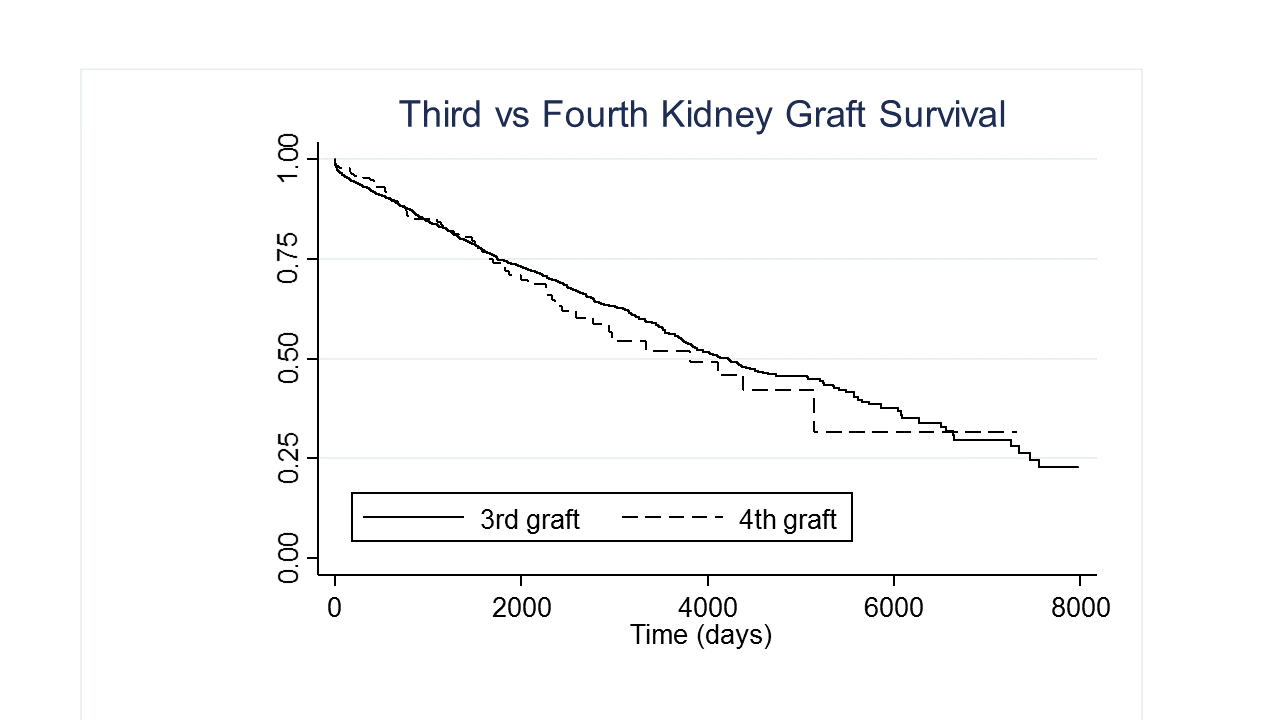Graft Survival of Fourth Time Renal Transplant Recipients Are Similar to Third Time Transplants: A SRTR Database Analysis
Hennepin County Medical Center, Minneapolis, MN
Meeting: 2019 American Transplant Congress
Abstract number: A210
Keywords: Graft failure, Kidney transplantation, Resource utilization, Risk factors
Session Information
Session Name: Poster Session A: Kidney Deceased Donor Allocation
Session Type: Poster Session
Date: Saturday, June 1, 2019
Session Time: 5:30pm-7:30pm
 Presentation Time: 5:30pm-7:30pm
Presentation Time: 5:30pm-7:30pm
Location: Hall C & D
*Purpose: The number of candidates for repeat kidney transplant in the United States has steadily increased over the last 30 years. Second and third kidney transplants are known to improve patient survival over long-term dialysis. However, graft and patient survival is inferior to primary kidney transplants. Little is known about the outcomes after fourth time kidney transplants.
*Methods: We retrospectively compared characteristics of third and fourth kidney transplants utilizing the SRTR database performed in the US between 1990 and 2018 and then created a multivariate regression model to determine characteristics associated with graft and patient survival of third time kidney transplants and fourth time kidney transplants.
*Results: During the study period, there were 3,055 third and fourth time kidney transplants performed in the United States. Of these, 232 patients received a fourth renal transplant (162 from deceased donors and 70 from living donors). Overall fourth time graft survival was not statistically different from third time with living or deceased donors despite a larger percentage of living donors utilized in the fourth transplant group compared to third transplant (HR 1.07, P=0.61) (Figure 1). Compared with third transplants, patients receiving a fourth transplant from a deceased donor had significantly fewer HLA mismatches but otherwise had similar donor and recipient characteristics including incidence of delayed graft function, cold ischemia time, and percentage of DCD and ECD donors (Figure 2). There was no significant difference in patient survival observed, though a small sample size limits evaluation of this outcome. Factors significantly associated with decreased graft survival included recipient and donor age, recipient and donor being African American, degree of HLA mismatch, peak PRA, delayed graft function, DCD, and transplant era.
*Conclusions: Fourth kidney transplants are comparable to third transplants in terms of graft and patient survival. Factors that influence these outcomes are generally in line with factors previously described for earlier transplants.
To cite this abstract in AMA style:
Petrun B, Nygaard R, Hill M, Richardson C, Israni A, Stahler P. Graft Survival of Fourth Time Renal Transplant Recipients Are Similar to Third Time Transplants: A SRTR Database Analysis [abstract]. Am J Transplant. 2019; 19 (suppl 3). https://atcmeetingabstracts.com/abstract/graft-survival-of-fourth-time-renal-transplant-recipients-are-similar-to-third-time-transplants-a-srtr-database-analysis/. Accessed December 13, 2025.« Back to 2019 American Transplant Congress

